Content marketing for eCommerce has never been more competitive, but the brands winning market share here are building trust and loyalty through their content, not just selling good products.
Our team at Influize has put this guide together to highlight how to make your content do more. This includes using first-party data and tactics that generally cut through the noise and drive measurable growth.
You’ll see which content formats convert best in 2025, and how to maximize your reach through SEO.
The Role of Content in eCommerce Growth
Why is content important for online stores? Because it:
- Drives organic growth
- Builds brand authority
- Fuels conversions in ways traditional ads can’t
High-quality content brings traffic to your website from search engines and social media because it answers customer questions. Paid search stops when your budget runs out. Well-ranked articles or videos bring in new shoppers week after week.
And nearly half of buyers read a company’s blog when evaluating a purchase. So if your online store provides helpful articles or how-tos, you’re positioning yourself as a trusted advisor rather than just a vendor.
Every product guide or FAQ you publish is a chance you rank on Google. And it’s because of that that content marketing gives you 3x more leads per dollar than traditional advertising and costs just over 60% less, since you’re getting more organic search traffic.
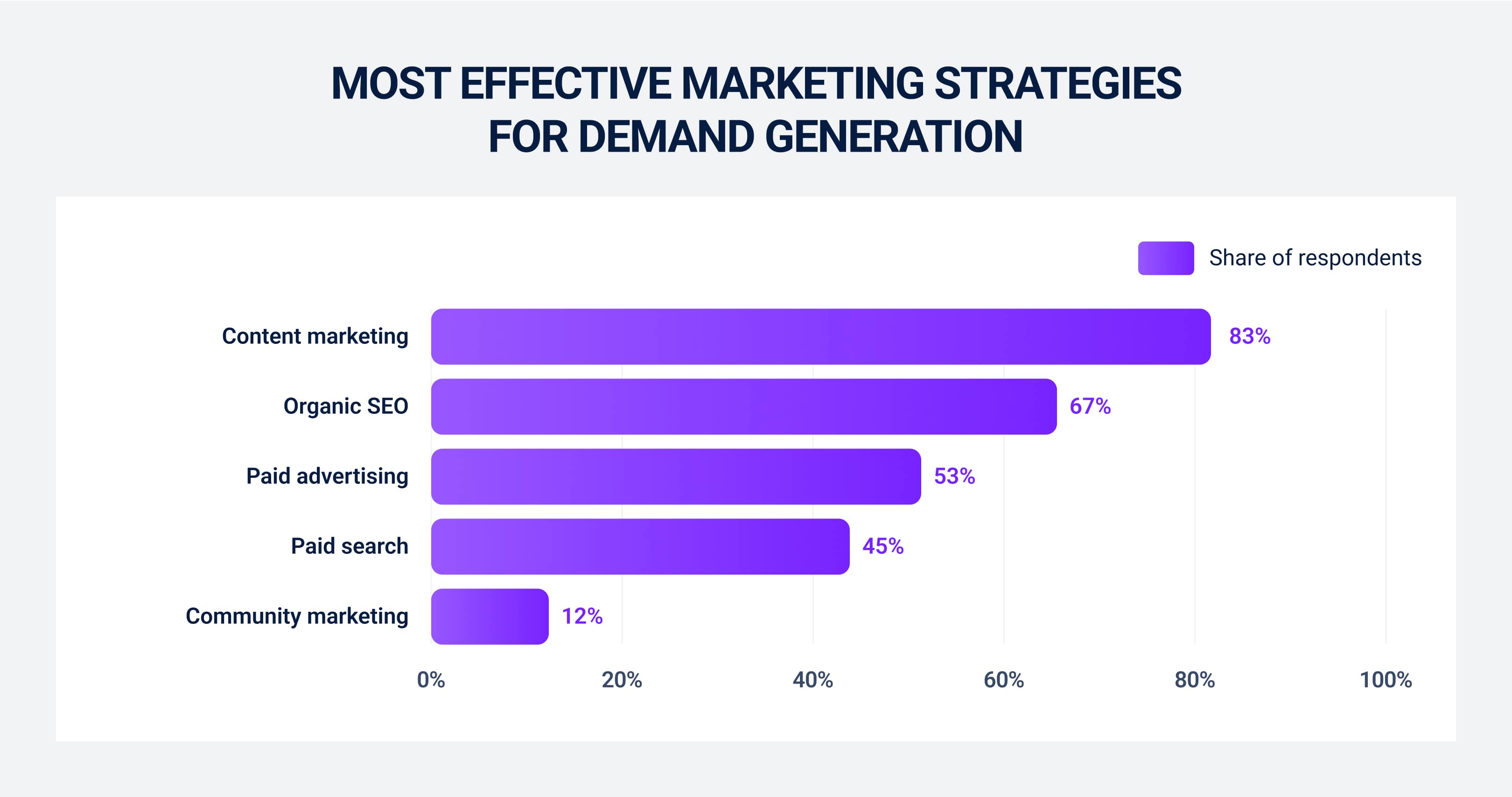
How to Craft a Bulletproof Content Strategy for eCommerce
You need a plan that ties together your business goals and the realities of SEO and competition:
| Strategy Component | Key Actions & Outcomes |
|---|---|
| Define Your Core Content Pillars | Find some focus themes (tutorials, product guides) that align with your niche so you can brainstorm topics. |
| Align Content to Funnel Stages (TOFU, MOFU, BOFU) | Map each of those topics to awareness, consideration, decision. TOFU posts build interest, MOFU guides compare solutions, BOFU pages drive conversions. |
| Competitive Gap + SERP Feature Audit | Look at your competitors’ content for any topics you’re missing. Check out SERP features (featured snippets, video/carousels) and make your format capture those |
| Know Your ICP Better Than They Know Themselves | Learn about buyer personas from surveys and support feedback. Then you can tailor your content tone and CTAs to address their core pain points and desires. |
| Use First‑Party Data to Guide Your Content Calendar | Utilize site search queries and CRM insights so you can prioritize high‑interest topics. Plan seasonality and update evergreen pieces based on real engagement data. |
| Develop a Scalable Content Production Workflow | Create an editorial calendar and a project management process. Hire a freelancer for your writing and website design if you’re struggling to maintain quality at scale. |
| Collaborate with Product & Sales Teams from Day One | Involve product managers for feature insights and sales/customer‑service teams for FAQ-driven topics. Use their input for any case studies and buying guides you make. |
| Prioritize Commercial Value Over Search Volume | Focus on keywords and topics with high purchase intent (look at CPC and ad competition) rather than broad, low‑intent terms. Then link your content directly to relevant products or paid search pages. |
| Build Authority Around Micro‑Niches First | Target specific subtopics (e.g., “trail running tips for beginners”) to establish yourself. After this you focus on linking those niche articles to other ones to build authority. |
| Integrate Brand Storytelling into SEO Content | Talk about customer case studies or your origin story into optimized content. Anecdotes are helpful here because they make SEO articles feel human and memorable. |
Killer Content Types That Convert in 2025
These are the content formats that get the most joy in 2025. They are engaging, shareable, and built for how people consume media today.
High-Converting Product-Led Blog Posts
Some of the best eCommerce blogs are product-led, which means they provide valuable info and seamlessly weave in their products as part of the solution.
If you sell home office equipment, you might traditionally post a blog like “10 Tips to Stay Productive at Home.” But this is generic. A product-led approach would be “10 Home Office Upgrades for Maximum Productivity” where you genuinely discuss useful upgrades and you happen to sell some of those items.
You explain why a standing desk improves their focus, but casually mention “Our ErgoLift Standing Desk” as an example with a quick spec or benefit. It doesn’t feel pushy because it’s relevant. They learn and start considering your product as a solution.
But make sure your content stands on its own merit without the product plugs. The info should be genuinely useful. And limit how many products you mention to avoid coming off as too salesy.
Interactive Content That Engages and Attracts Backlinks
People live voting or playing something, so interactive content is useful for eCommerce engagement. Static text is fine, but if you can turn a piece of content into an experience, you’ll keep visitors hooked longer and make a lasting impression.
Quizzes and assessments are great examples of guiding product selection in a fun way. You answer a few quick questions, then the quiz gives you a curated list of products. Not only does this engage the user, but it also directly drives them to relevant items.
It feels like a service, not a sale. And it earns you high‑quality backlinks as other sites share your tools.
BuzzFeed Quizzes
BuzzFeed does this well. They do lots of personality quizzes (e.g., “Which ‘Stranger Things’ Character Are You?”) that routinely generate millions of views and social shares. And these quizzes’ viral nature is perfect for organic backlinks (from fan blogs to media roundups) which plays into BuzzFeed’s authority and traffic.

Sephora
Sephora does this even better from an ecommerce standpoint with a highly tailored recommendation quiz. You can specify everything from particular skin concerns to preferred product categories.
And at each stage, all your choices are guiding you toward the perfect match. When the quiz ends, you’ll get multiple recommendations, so customers can compare and decide which items suit them best.
Because it educates and offers tailored advice, people are eager to share it with friends, which spreads even more awareness of what they offer.
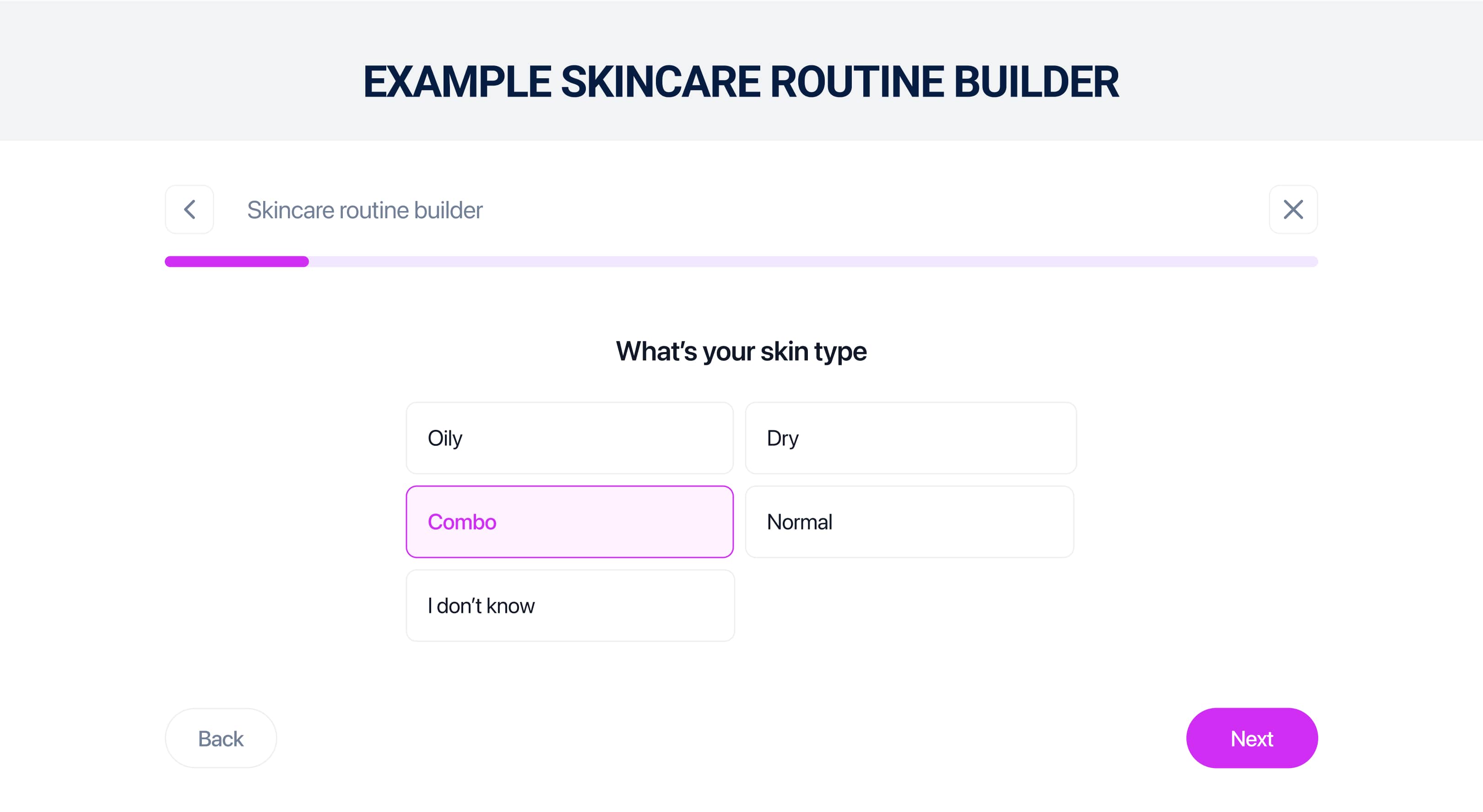
How Effective Is Interactive Content?
Interactive content generates ~50% more engagement than static content. More engagement means visitors stick around, which can improve SEO signals and certainly gives more opportunity to persuade.
Also, interactive content often has higher conversion because it’s personalized. When someone completes a quiz and sees “Your perfect solution is Product X,” that’s a strong nudge and it feels tailor-made.
It also doesn’t always require heavy dev work. Even embedding a Google Form with some logic can do the trick for a quick quiz.
UGC-Infused Pages That Build Trust and Rankings
UGC in eCommerce means things like:
- Customer reviews
- Ratings
- Photos from customers
- Q&A sections where users ask and answer questions
- Testimonials
- Social media feeds of customers using your product
- Integrating these into your site can significantly boost conversion and SEO at the same time.
Trust and Conversion
Shoppers heavily rely on peer opinions and always scan the reviews. Displaying reviews and ratings can increase conversion rates by up to 270% in some studies, especially for higher-priced items where reassurance is needed.
We trust what others like us say more than the polished sales copy. So if your product pages aren’t already loaded with reviews, that’s step one: encourage customers to leave them (offer loyalty points or just a polite post-purchase email request). Then showcase them clearly.
SEO Benefits
UGC means constantly updated content without any effort on your end. For example, a customer might write, “This running jacket kept me warm in 30°F weather and fits true to size.” Now your page has keywords like “running jacket warm 30°F” or “fits true to size” which are phrases potential buyers search or that address their concerns.
Google notices these updates and the relevancy of that content to long-tail queries. Additionally, having FAQ sections on product pages where either staff or customers answer common questions (like “Is this machine washable?”) can land you in Google’s People Also Ask or at least satisfy those who scroll.
If you can implement a feature where customers can ask a question and you (or other customers) answer, that’s even better because it’s UGC plus expert input.
Just make sure you monitor UGC for quality and appropriateness. You want honest opinions, even if not all are five-star (a mix of reviews actually lends credibility), but filter out any spam or offensive content.
GROW YOUR INSTAGRAM FOLLOWING VIA OUR CELEBRITY CAMPAIGNS
Leverage the power of the worlds A-list celebrities to grow your Instagram every month
VIEW CAMPAIGNSVisual Storytelling with Shoppable Media
Customers are drawn to images and videos let them take action (like buying) right then and there:
Shoppable Images and Videos
You’ve probably seen these on Instagram or Pinterest - an image where you can hover or tap on a product and get details or a purchase link. Many brands now incorporate look books or style galleries on their site that are interactive.
For example, a furniture store might have a beautifully styled living room photo where each item (sofa, lamp, rug, wall art) in the scene is clickable, so you can directly shop that exact product.
It’s a seamless way to go from “Oh, I love that look” to “Add to cart.” You can do something similar on your own blog or content pages. If you post a recipe on your cooking store’s blog, make the image of the finished dish shoppable, where clicking the pan used in the photo takes you to that pan’s page.
Short-Form Video (UGC Style)
Embedding short videos on your product pages or content can boost engagement. For instance, you could embed a 15-second try-on clip or a customer’s TikTok review on the product page if you’re a clothing retailer.
Plus, Google is increasingly showing short videos in search results for how-to and product queries (You might have noticed a “Short Videos” carousel pulling from TikTok or Instagram on some searches).
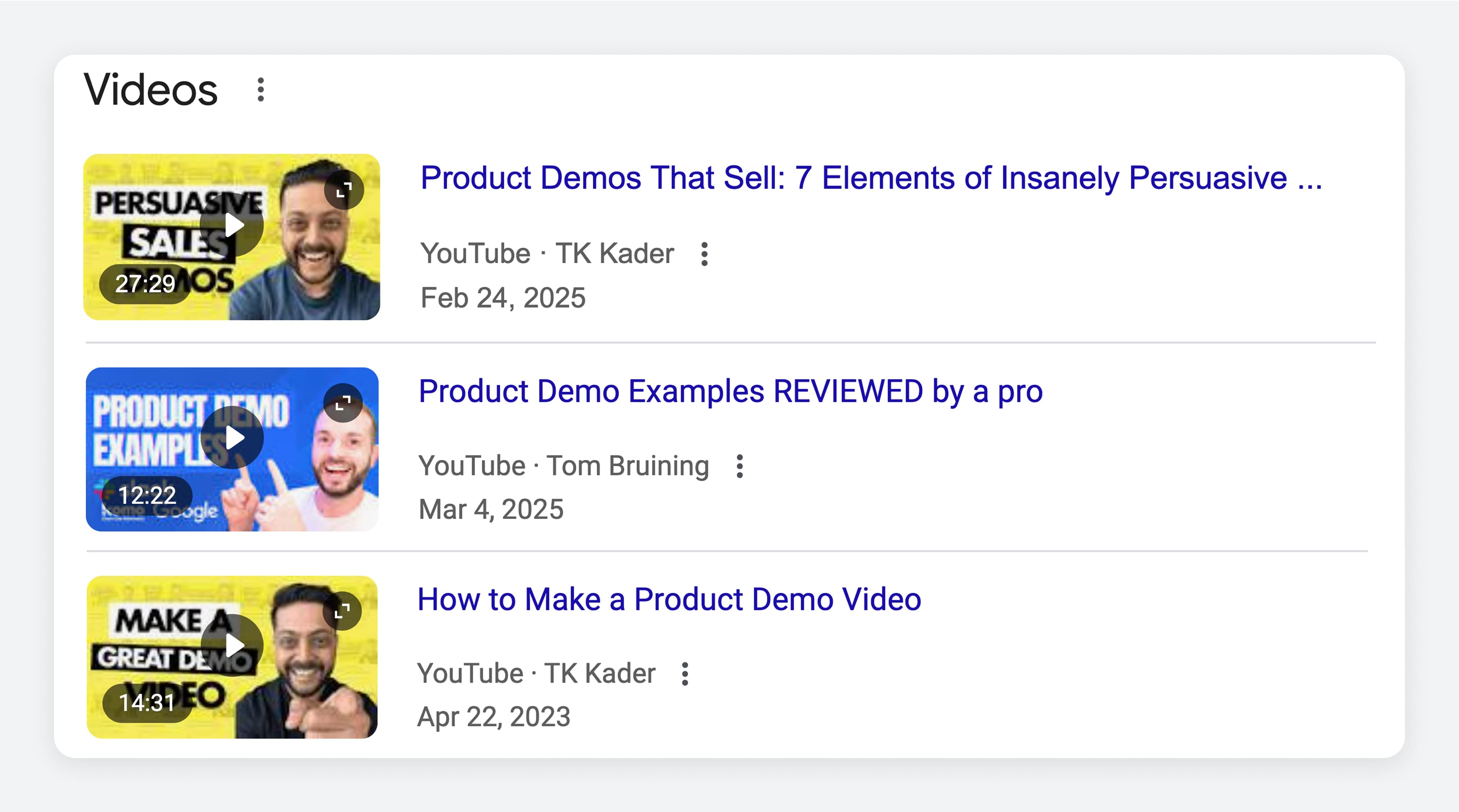
In terms of storytelling, you should use imagery to highlight your brand lifestyle. If you sell outdoor gear, your visual content should make viewers feel the adventure (panoramic drone shots of a hiker reaching a summit wearing your gear), with maybe a caption or short overlay text that speaks to the heart (“Conquer more peaks”).
It makes them aspirational: this could be you. And conveniently, all the gear in this video is one click away.
Platforms reward this native visual approach. Google’s algorithms and users heavily favor visual content. In fact, videos appear in 78% of Google search results pages in the U.S., which shows how much Google integrates video now.
And TikTok is essentially a search engine for Gen Z. Over half of Gen Z prefer TikTok or Instagram for search over Google for certain queries. That means if you’re creating native-feel, visually rich content, you’re not only engaging on your site but potentially capturing those audiences on their preferred platforms too. Meeting them where they already are.
Also consider AR (Augmented Reality) if it’s accessible. You can use an AR tool that lets users visualize a couch in their own living room via their phone camera. Not every business can do this easily, but the tech is becoming more plug-and-play with things like Shopify AR.

SEO Meets Storytelling: The Smart Way to Win Organic Traffic
People see SEO content as dry, robotic stuff just to please Google and that “storytelling” is a fluffy branding exercise. The best content marketers know that combining these approaches is best.
Topic Clusters Around Commercial + Informational Keywords
To dominate SEO without churning out soulless articles, take a topic cluster strategy that mixes commercial and informational content under big umbrella themes. We touched on content pillars and micro-niches; this is the SEO execution of that concept.
Here’s how it works:
- Pick a broad topic that’s crucial for your business (say, “smart home security”).
- Create a cluster of content that covers it from all angles. Some pieces will target commercial keywords (e.g., “Best Smart Home Security System 2025,” which implies the reader might be ready to compare/purchase systems, a high-intent query).
- Other pieces go for informational keywords (e.g., “How to Secure Your Home on a Budget” or “Smart Home Security Tips for Renters,” which are earlier in the funnel, educational queries).
Link these pieces together naturally. The informational posts can each include a section or CTA that points to the comparative or product page (e.g., after giving general tips, mention “for a rundown of top-rated solutions, check out our Best Systems guide”).
The commercial-intent page can have links back to the informational resources (“New to smart security? Read our beginner’s guide to see what features matter most.”). This internal linking blueprint guides readers to other relevant info no matter where they start, and also signals to Google that you have a comprehensive coverage of the topic.
By owning both sides (informational and commercial), you effectively own the full funnel in your niche on search.
A user might:
- First encounter your brand via an informational query
- Find your article helpful
- Search a product comparison and again find your content (or even remember your site and go directly) later when they’re closer to buying.
You become their trusted resource throughout their journey. For example, a fitness equipment retailer can have a cluster around “home gym setup.”
- Informational Content: “How to Start a Home Gym for Under $500,” “Home Gym vs Gym Membership: Pros and Cons,” “10 Essential Exercises for Home Workouts.”
- Commercial Content: “Best Home Gym Equipment Packages,” “Treadmill vs Elliptical: Which to Buy?,” etc. Interlink them.
A reader lands on the $500 budget article, gets great tips, then clicks into “best equipment packages” when they’re convinced to invest. Internally, you have effectively built a net that catches them at any stage.
Also, you tend to cover many related keywords when you cluster content. Google sees that if someone searches a question and you happen to answer it within a larger article, they might still show your page. And if not, you likely have a dedicated piece that does.
Just ensure each piece in the cluster has a distinct focus and doesn’t cannibalize the others. Define a clear keyword and intent per page. If two pages would essentially answer the same query, combine them or differentiate their angle. The cluster should be more “one big topic with subtopics,” not a bunch of duplicates.
When you nail topic clusters, you’ll see multiple pages of your site capturing top rankings around a theme. You’re establishing your website as the authority source for that subject. Every page addresses a specific question and they’re all connected by links.
Technical SEO and Structured Data for Content Assets
You don’t need to be a developer to get the basics right:
Site Speed and Mobile Optimization
Your content pages need to load fast, especially on mobile. A huge portion of eCommerce traffic is mobile, and Google uses mobile-first indexing, which means it looks at your site's mobile version primarily.
Large images or clunky scripts can hurt load times, which can in turn hurt rankings and annoy users. To avoid that:
- Use compression for images
- Implement AMP for articles (Accelerated Mobile Pages) if relevant
- Follow best practices (minify code, utilize CDNs, etc.)
This is more on your development team, but as a content creator, you can still use tools like Page Speed Insights to flag if your pages are sluggish. A fast site not only ranks better but also converts better (impatient shoppers leave slow sites)
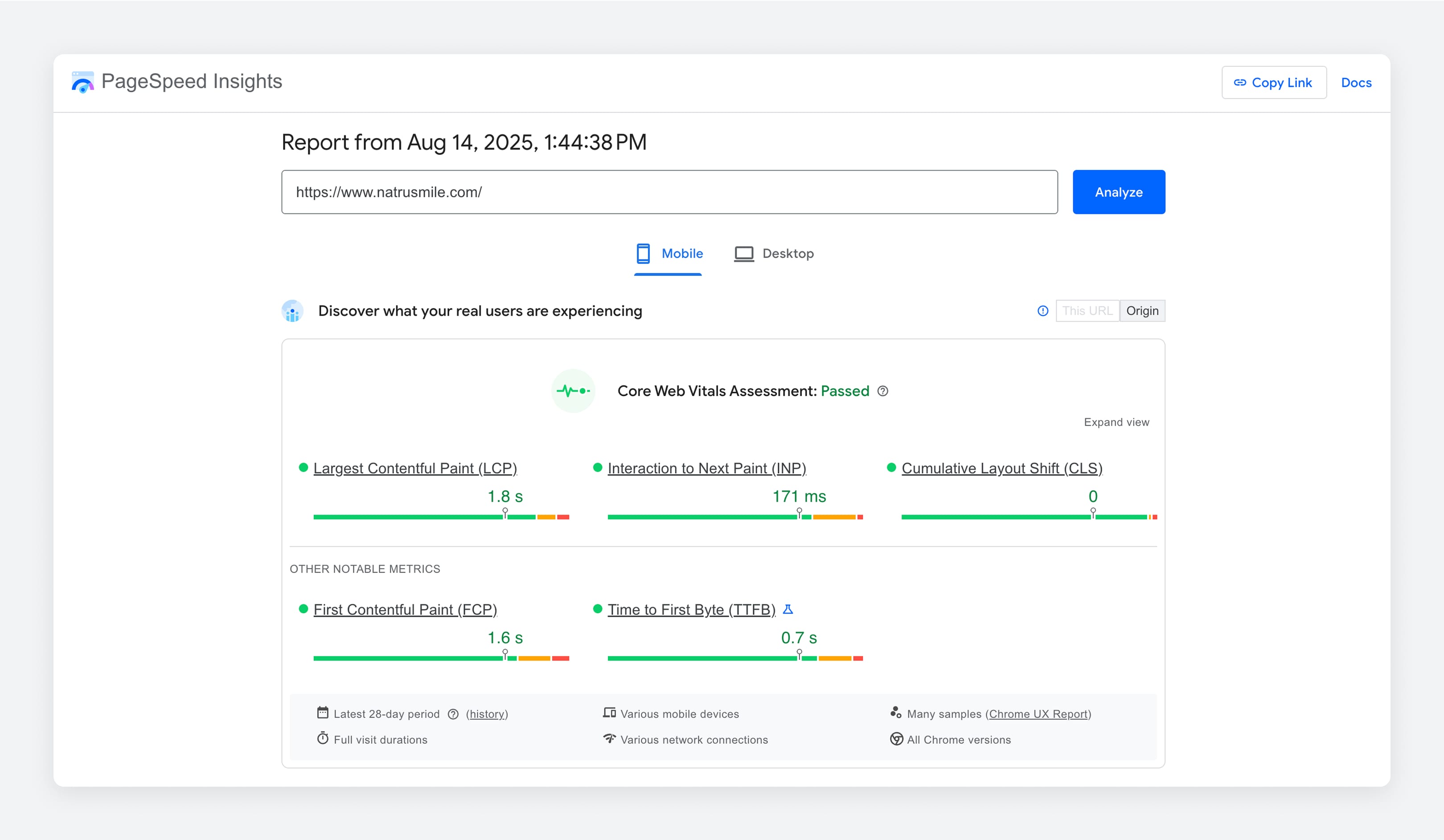
Structured Data (Schema Markup)
This is code you add to your pages to help search engines understand what the content is and enable special search result features. For eCommerce content, consider these schemas:
- Product schema on product pages (includes price, availability, review ratings). This can make your listing show star ratings and price in Google results.
- Review schema if you have a standalone review article or even on product pages if it’s an editorial review.
- FAQ schema on pages that have a Q&A format (many blogs now add an FAQ section at the end with schema, which can make those questions appear in the search result as dropdowns - prime SERP real estate).
- How To schema for step-by-step guides. If you have content like “How to assemble X”, marking it up could land you in a nice rich snippet with the steps listed out (possibly even with images you provide for each step).
- Video schema if you embed videos. This improves the chance of getting a video thumbnail next to your result or showing up in video search.
- Article or Blog Posting schema for your blog posts in general, giving Google clear info like the author, publish date, etc.
There are plugins/apps that handle a lot of the technical stuff here if you use popular platforms like WordPress or Shopify. Also, Google’s Structured Data Markup Helper can help you with adding JSON-LD code.
It’s definitely worth the effort because rich results can dramatically improve click-through rates. For example, an FAQ-rich result takes up more screen space on mobile. This pushes your competitors down and invites the user to click for full answers.
Fix Duplicate or Thin Content
If you have lots of similar content pieces (perhaps from product descriptions or variants), use canonical tags or consolidate them
For instance, if you guest post or something, canonical back to your original to avoid confusion. This is more an SEO housekeeping tip, but it’s important because sometimes eCommerce stores have print versions of pages, or the same article accessible via multiple URLs. Those should ideally be cleaned up to not dilute SEO.
Voice Search and Featured Snippets
Phrasing some of your content in a question-and-answer format can help. People often voice search like “Hey Google, how do I remove wine stains from carpet?” If your content has a clear Q&A or a step list that directly addresses that, you increase your chances of being the source of the spoken answer. This ties back to structured data (FAQ, HowTo schema) and just writing in natural language.
Evergreen + Seasonal Campaigns
You want both evergreen content that’s relevant year-round and seasonal or campaign-based content that spikes at certain times:
Evergreen Content
These are topics that don’t go out of style. For an eCommerce example, if you sell coffee machines, an evergreen piece would be “How to Clean and Maintain Your Coffee Machine;” useful in any season, any year
Evergreen posts are great for covering:
- How-tos
- Definitions
- Classic top 10 lists (that you update as needed)
- Buyer’s guides
You create them once and then just refresh periodically to keep them accurate. They build authority and can rank for years with minor tweaks.
Seasonal Content
This is tied to events, holidays, or yearly trends. Almost every eCommerce business has seasonal peaks:
- Black Friday
- Christmas
- Back-to-School
- Summer Vacation
So creating content ahead of these times can pay off big. For instance, a clothing retailer should have content like “Summer 2025 Fashion Trends” or “Winter Layering Guide”. These will have a surge in interest at specific times.
They might not get much search volume in off months, but when in season, they could draw tons of traffic and conversions. If you want to rank or get traction by, say, November for holiday content, publish it in October (or earlier). This way Google has time to index and rank it, and you can promote it as the season kicks in.
But don’t silo seasonal vs evergreen; link them when you can. Your evergreen “How to choose a laptop” article can link to a seasonal “Back to School Laptop Deals” post during that period. And vice versa, the seasonal post can point back to foundational evergreen guides for readers who want more depth.
How to Track ROI of E-commerce Content Marketing
Tracking your ROI helps you justify your content spend and double-down on what works (and cut what doesn’t).
Use Analytics Tools
Set up Google Analytics 4 (GA4) or your preferred analytics tool on your site.
- Use UTM parameters on any content promotion links (like in emails or social) so you can attribute visits and sales to that content.
- In GA, you can check the behavior flow or landing page report to see how visitors from content navigate and if they end up purchasing.
- Enable ecommerce tracking in GA to get revenue data. Then you can create segments or use the conversion path tools to see if users who engage with content have a higher conversion rate or if content pages appear in conversion paths.
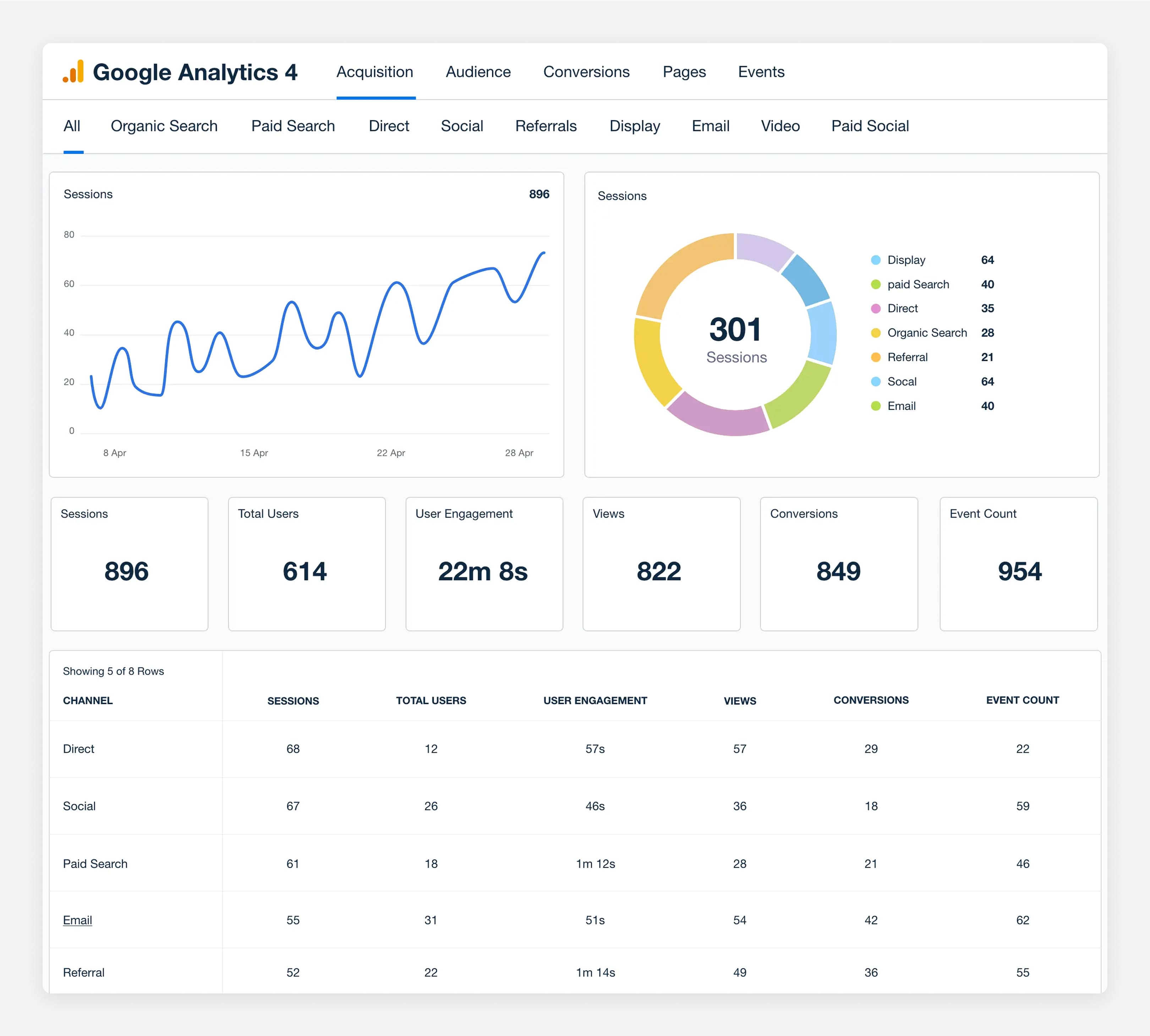
Attribution Models
Decide how you credit content with sales. There’s first-touch (content brought them in initially), last-touch (content was viewed right before purchase). And there are multi-touch models. For content marketing, a multi-touch or assisted conversion report helps because often a blog post is the introduction (first-touch) or mid-funnel assist, rather than the very last click before purchase.
GA4 has a cool Attribution section where you can see “Assisted Conversions.” This lets you check how many sales were influenced by users visiting certain pages.
For instance, you might find that over the last quarter, 50 purchases happened by users who at some point visited your “Buying Guide” page. That’s a strong indicator the guide is driving value, even if it’s not the final page before checkout.
Tie Revenue to Content
Some content will have direct sales (like someone lands on a blog and immediately buys a linked product). Others influence indirectly. So it helps to set up goals in GA for things like:
- “Viewed Product Page”
- “Added to Cart”
- “Completed Purchase”
Then in GA, you can see the goal completion rate for traffic that came via content pages vs other pages.
If you have a login or lead capture, track how content moves people along (like sign-ups for a newsletter after reading a post = lead generated).
Use Unique Discount Codes or Links
If you published a specific content piece with a promo (like “Use code BLOG15 for 15% off”), you can measure how many sales used that code, which lets you attribute those sales to that content campaign. Similarly, affiliate-style tracking links or landing pages can isolate the traffic coming in from your affiliate marketing campaign.
Calculate ROI
Once you have numbers, say a particular content piece was directly or indirectly involved in $5,000 of sales this month, compare that to what you spent on it (time, money on writers/design, promotion costs).
This looks like:
ROI = (Return - Investment) / Investment x 100%. If that blog cost $500 to produce and brought $5,000 in sales, ROI = (5000-500)/500 x 100% = 900%.
Content KPIs Beyond Dollars
Content can offer value in brand building which is hard to put a number on immediately. That’s where proxy metrics come in (like increased branded search volume, social followers, or email list growth attributable to content).
These may eventually lead to revenue, so use a scorecard that includes both direct revenue metrics and those softer metrics.
Final Takeaways
Always remember to diversify your content types. Use everything from guides and infographics to short videos and podcasts. Whatever formats best convey your message. And remember that different people prefer different mediums, and different platforms reward different content types.
Furthermore, utilize your team and data. Make sure you speak with your sales and customer service teams for more content ideas and expertise. Also, consistently review your analytics and KPIs: see what’s working and what’s not so you can adjust.
And lastly, stay experimenting and innovating! What’s killing it on TikTok today might be a new platform tomorrow, so be ready to pivot and try new things.
Frequently Asked Questions
How Does Content Marketing Drive E-commerce Sales?
Content marketing draws in interested shoppers with helpful info and guides them toward your products. Any good blog post or video answers questions and subtly showcases items, so when they’re done looking at the content, they’re more confident and ready to buy.
Should E-commerce Businesses Blog Regularly?
Yes! Regular blogging (e.g., weekly or biweekly) keeps your site fresh for both readers and search engines. Each high‑quality post is a new opportunity to rank and get more traffic. Try to focus on relevance and depth over frequency to turn your blog into a reliable traffic and lead source.
How Can Product Guides Improve Conversions?
Product guides tell your buyers about features and use cases, which makes their decision‑making process easier. And by addressing FAQs, you’re building more confidence. Informed shoppers convert at higher rates because they feel educated. This reduces hesitation and cart abandonment.
Is Video Content Important for E-commerce Marketing?
Absolutely! Video brings your products to life in ways text can’t. Short demos or customer clips also boost engagement and trust. Google and social platforms favor video, which helps your SEO and conversion rates by making your product’s value instantly clear.
What Platforms Are Best for Distributing E-commerce Content?
Start with your own website (SEO) and email list. Then use visual platforms, like Instagram and TikTok, for shoppable media. YouTube is ideal for longer tutorials; Facebook/LinkedIn are better for community and thought leadership. It helps if you choose channels where your target audience already engages and to tailor the content to each format (portrait videos for TikTok, etc.).

